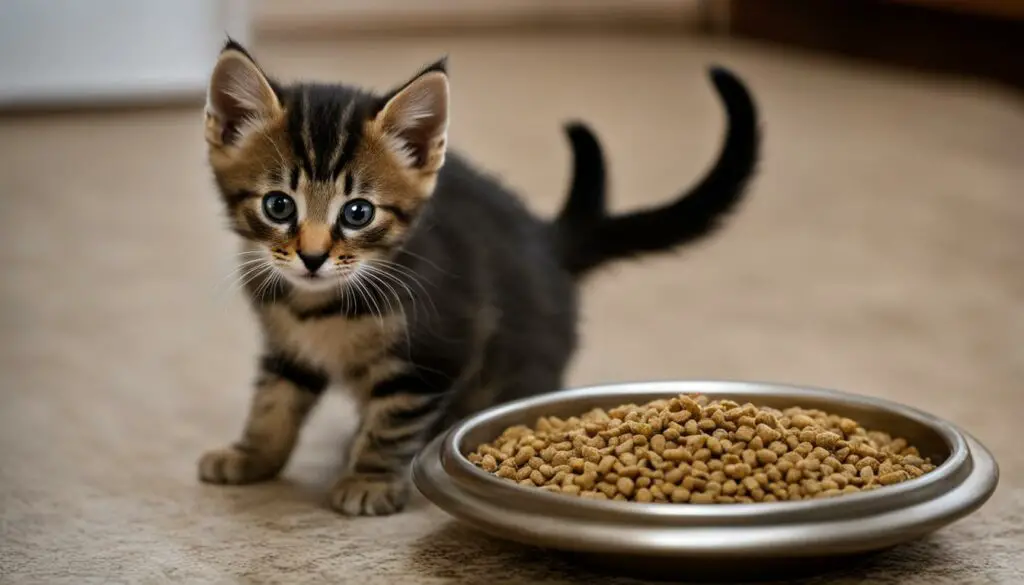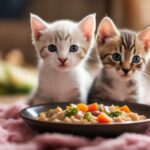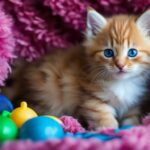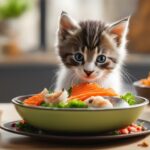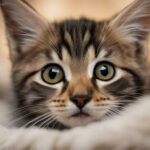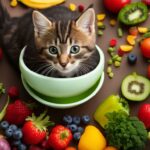Giving your kitten the right food is crucial for their growth and development. Kittens have specific nutritional requirements that differ from adult cats. Feeding them adult cat food can have consequences and potential health risks. In this article, I will explore the impact of kittens eating older cat’s food, the importance of proper nutrition for kittens, and provide tips on managing feeding habits for both kittens and older cats.
Your kitten’s diet plays a vital role in their overall health and well-being. Feeding them a complete and balanced kitten formula until they are at least 1 year old is recommended. This ensures they receive all the essential nutrients they need for healthy development. The nutritional needs of kittens are different from those of adult cats, and not providing the right food can lead to nutritional deficiencies.
During the first 6 months of life, kittens experience rapid growth and require increased levels of protein, energy, and minerals such as calcium and phosphorus. These nutrients are essential for their growth and development. It is important to provide them with a kitten formula that meets their specific nutritional requirements.
If your kitten accidentally eats adult cat food, there may not be any immediate harm. However, regularly feeding them adult cat food can lead to nutritional deficiencies and hinder their optimal growth. It is important to prevent your kitten from eating the older cat’s food to ensure they receive the right nutrients.
Managing feeding habits for kittens and older cats is essential. Providing separate feeding areas and consistent brand and type of food can help prevent the kitten from accessing the older cat’s food. Simple observations of their behavior and preferences can also assist in managing their feeding habits effectively.
Key Takeaways:
- Feeding kittens a complete and balanced kitten formula is crucial for their healthy development.
- Kittens have specific nutritional requirements during their growth stage that differ from adult cats.
- Regularly feeding kittens adult cat food can lead to nutritional deficiencies and hinder their growth.
- Managing feeding habits by providing separate feeding areas and consistent food can prevent kittens from eating older cat’s food.
- Observing the behavior and preferences of kittens and older cats helps in managing their feeding habits effectively.
The Importance of Proper Nutrition for Kittens
Proper nutrition is crucial for the healthy development of kittens. During their first 6 months of life, kittens experience rapid growth and have specific nutritional requirements that differ from adult cats. It is important to provide them with a complete and balanced kitten formula to ensure they receive the necessary nutrients.
Kittens require increased levels of protein, energy, and minerals such as calcium and phosphorus to support their growth. Protein is the main building block essential for their development, and they need a minimum of 30% protein in their diet on a dry matter basis. Amino acids, which are the building blocks of proteins, must be provided in their food as the body cannot produce them. Additionally, kittens need higher levels of fat for energy and omega-3 fatty acids like DHA and EPA for brain and retinal function.
Calcium and phosphorus are crucial for bone and muscle development in kittens. However, it is important to keep the ratio of these minerals within a narrow margin of safety to prevent growth deformities. Commercially prepared kitten food that meets the nutritional requirements established by the American Association of Feed Control Officials (AAFCO) or the European Pet Food Industry Federation (FEDIAF) is recommended to ensure optimal growth.
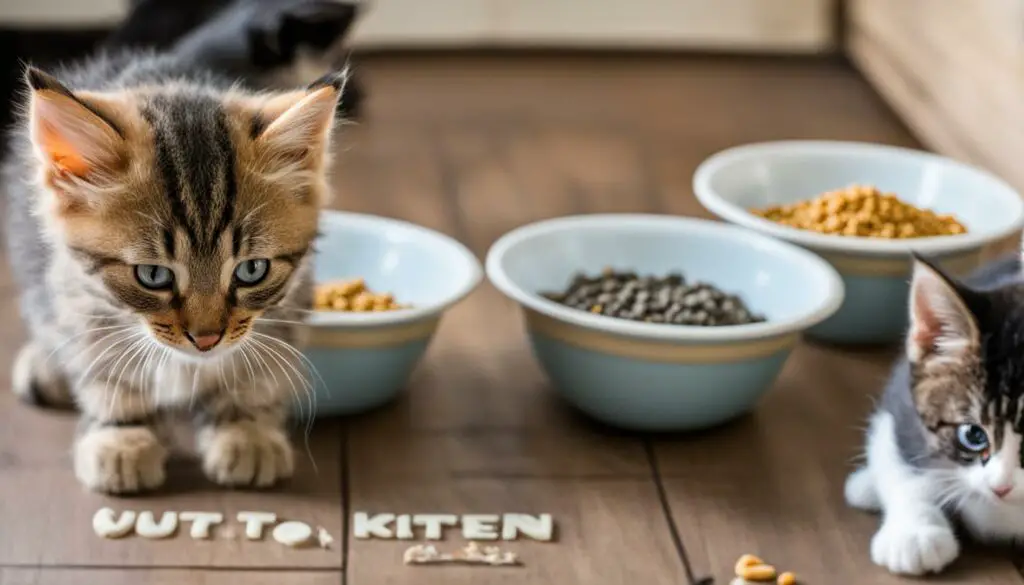
The Importance of Proper Nutrition for Kittens
In summary, providing proper nutrition is essential for the healthy development of kittens. They have specific nutritional requirements during their growth stage, including increased levels of protein, energy, and minerals. Kittens also need higher levels of fat and omega-3 fatty acids for energy and brain function. Calcium and phosphorus are crucial for bone and muscle development, but the ratio of these minerals must be carefully balanced. It is important to feed kittens a complete and balanced kitten formula that meets their specific nutritional needs to ensure optimal growth and development.
The Life Stages of Cats
Understanding the different life stages of cats is essential for providing them with the right care and nutrition at each phase of their lives. Cats go through four main life stages: growth, adult, senior, and geriatric. Each stage is characterized by unique physical and behavioral changes, as well as specific nutritional needs.
Life Stage 1: Growth Stage (Kitten Stage)
The growth stage, also known as the kitten stage, begins at birth and typically lasts until around 10 to 12 months of age. During this stage, kittens experience rapid growth in terms of both size and development. They are highly active and require a diet that supports their growth and provides them with the necessary nutrients for healthy development.
Life Stage 2: Adult Stage
The adult stage starts after the growth stage and continues until around 7 to 10 years of age, depending on the cat’s breed and overall health. Adult cats are generally more settled and less energetic than kittens. They require a balanced diet that helps maintain their weight, supports their immune system, and keeps their overall health in check.
Life Stage 3: Senior Stage
The senior stage begins around 7 to 10 years of age and lasts until about 11 to 14 years old. During this stage, cats may start to experience age-related changes such as decreased mobility, dental issues, and changes in metabolism. Senior cats need a diet that takes these changes into account, providing them with the right balance of nutrients to support their aging bodies.
Life Stage 4: Geriatric Stage
The geriatric stage starts around 11 to 14 years of age and continues until the end of a cat’s life. Cats in this stage are considered elderly and may have additional health issues such as arthritis, kidney disease, or dental problems. A diet formulated specifically for geriatric cats can help manage these conditions and support their overall well-being.
Understanding the life stages of cats allows you to tailor their nutrition and care to their specific needs at each phase. Providing the right diet and attention throughout their lives can contribute to their overall health and longevity.
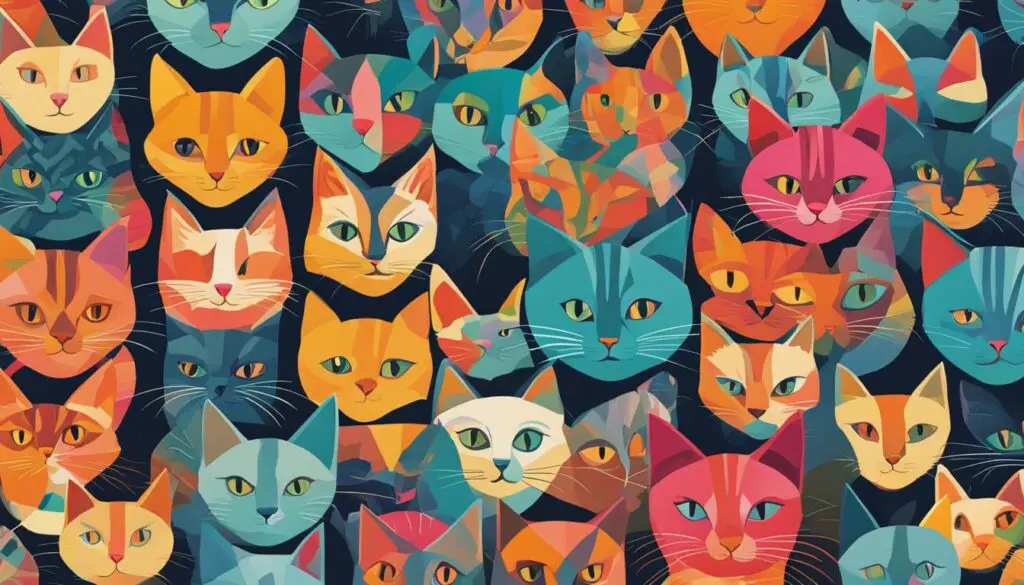
Weaning and Transitioning to Solid Food
When it comes to transitioning kittens from a milk-only diet to solid food, a gradual and careful approach is essential. This process, known as weaning, typically begins around 4 weeks of age. At this stage, kittens should be introduced to soft or wet food that is specifically formulated for their nutritional needs. Wet food is easier for kittens to eat and provides them with the necessary nutrients for healthy growth and development.
During the weaning process, it’s important to monitor the kittens’ progress and ensure that they are gradually transitioning to solid food. This can be done by initially mixing a small amount of wet food with milk or formula to create a soupy consistency. Over time, the amount of solid food can be increased while reducing the liquid until the kittens are fully weaned.
By the time kittens reach 2 months old, they should be completely weaned and ready to eat commercially prepared kitten food. This food can be either wet or dry, depending on the preference of the kitten. Some kittens may prefer wet food, while others may prefer the crunchiness of dry food. It’s important to provide a balanced diet that meets their nutritional needs and encourages healthy eating habits.
| Benefits of Wet Food | Benefits of Dry Food |
|---|---|
|
|
“The weaning process is a crucial stage in a kitten’s development, as it prepares them for a lifetime of eating solid food. By gradually introducing them to wet or dry food and monitoring their progress, we can ensure that kittens receive the proper nutrition to support their growth and development.” – Dr. Jane Smith, Veterinarian
Growth and Development in Kittens
Kittens experience their most rapid growth and development during the first year of life. In fact, during the first 24 weeks, kittens can increase their body weight by up to 40 to 50 times that when they were born. This incredible growth phase highlights the importance of providing kittens with the essential nutrients they need to support their development.
During this critical period, it is crucial to continue feeding kittens a complete and balanced kitten formula. Even though kittens may appear fully grown by 6 months of age, their internal development is still ongoing. Feeding them a kitten formula ensures they receive the specific nutrients required for their growth and overall well-being.
Proper nutrition is essential during this time to support bone and muscle development, as well as brain and retinal function. Kittens require higher levels of protein, amino acids, fat, omega-3 fatty acids, vitamins, and minerals to fuel their growth and provide the building blocks for a healthy body. Providing a diet specifically formulated for kittens will help ensure they receive these essential nutrients in the right amounts.
| Nutrient | Importance | Sources |
|---|---|---|
| Protein | Essential for growth and development | Animal-derived proteins like chicken, turkey, and fish |
| Fat | Provides energy and supports brain function | Poultry fat, fish oil, and canola oil |
| Omega-3 Fatty Acids (DHA and EPA) | Supports brain and retinal development | Fish oil and flaxseed |
| Vitamins and Minerals | Essential for overall health and development | Fruits, vegetables, and specially formulated kitten food |
By providing kittens with the proper nutrition during their growth stage, you can help set them up for a healthy and happy life. Be sure to consult with your veterinarian to determine the best diet and feeding plan for your kitten.
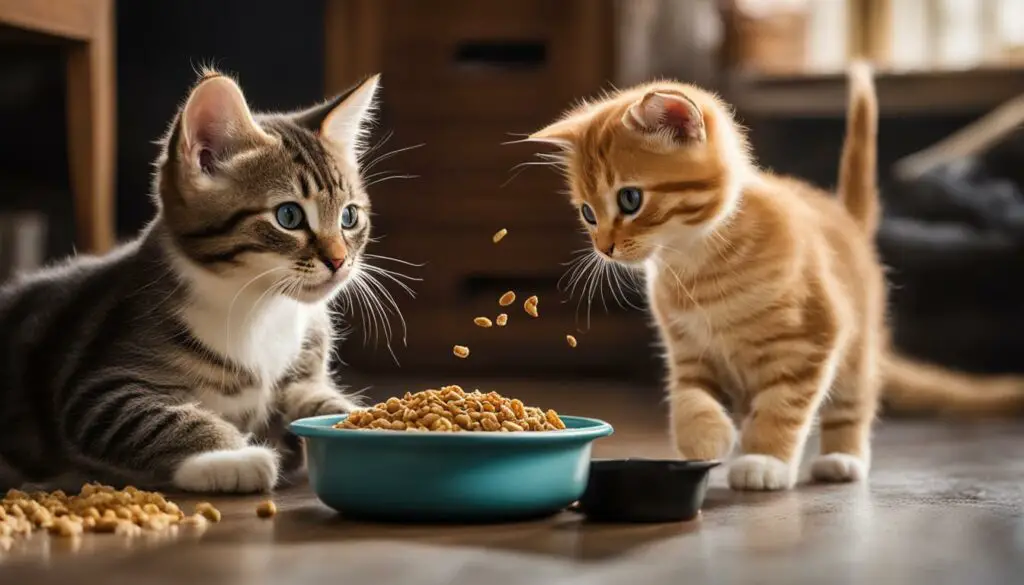
Nutritional Essentials for Growth in Kittens
Protein is one of the key nutritional essentials for the growth of kittens. They require a minimum of 30% protein in their diet on a dry matter basis. Protein serves as the main building block for their developing muscles, tissues, and organs. It is crucial for supporting their rapid growth and ensuring overall health. Amino acids, which are the building blocks of proteins, are also vital for kittens’ growth and development. These essential amino acids must be provided through their diet, as their bodies cannot produce them on their own.
Fat is another important nutrient for growing kittens. It provides them with the necessary energy to fuel their growth and development. Additionally, fat plays a crucial role in the absorption of fat-soluble vitamins and the development of their brain and retinal function. Omega-3 fatty acids, such as DHA (docosahexaenoic acid) and EPA (eicosapentaenoic acid), are particularly beneficial for kittens’ brain and eye development. These fatty acids can be found in fish oil and other sources of seafood.
In addition to protein and fat, kittens also require a wide range of vitamins and minerals for optimal growth. These include calcium and phosphorus, which are essential for their bone and teeth development. Kittens need higher amounts of calcium and phosphorus compared to adult cats. It is important to provide them with a balanced diet that meets their specific nutritional needs to ensure proper growth and development.
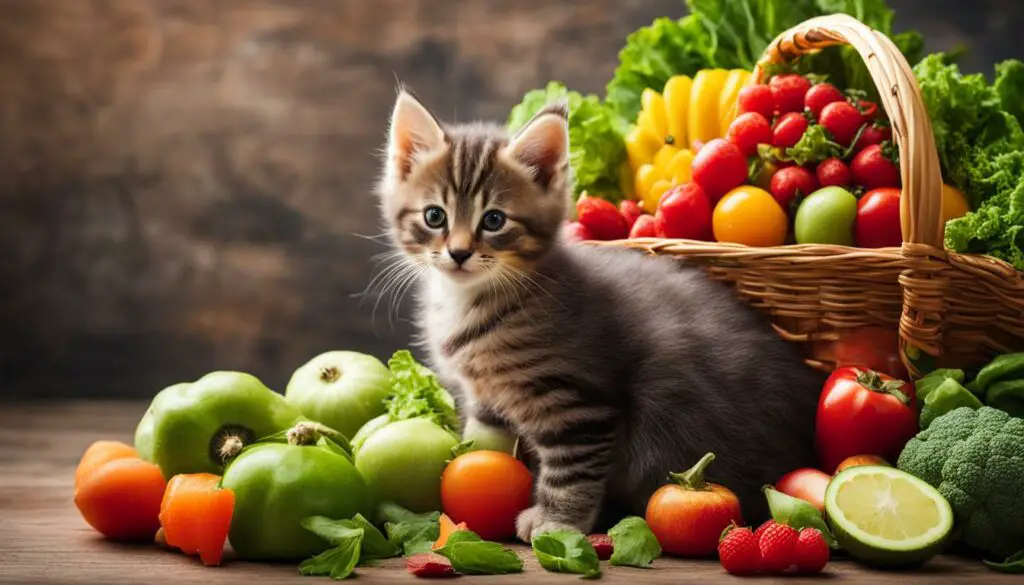
To summarize, kittens have specific nutritional requirements for growth and development. Protein is essential for building their muscles and tissues, while fat provides them with energy and supports brain and retinal function. Omega-3 fatty acids, vitamins, and minerals are also crucial for their overall health. Providing a balanced diet that meets these nutritional essentials is key to ensuring kittens grow into healthy adult cats.
Importance of Ingredient Quality
When it comes to feeding kittens, the quality of ingredients in their food plays a crucial role in their growth and development. High-quality ingredients are not only easily digestible but also provide the necessary nutrients for a balanced diet. Kittens require animal-derived proteins to meet their amino acid requirements, which are essential for their overall health and growth.
Choosing a kitten food that contains high-quality ingredients ensures that your kitten receives the necessary nutrients for optimal growth. Look for labels that indicate the food meets the nutritional requirements for kittens established by reputable organizations such as the American Association of Feed Control Officials (AAFCO) or the European Pet Food Industry Federation (FEDIAF). These organizations set standards for the nutritional content of pet food and ensure that it meets the specific needs of growing kittens.
By providing your kitten with a diet that consists of high-quality ingredients, you can help support their healthy development and growth. The easily digestible nature of these ingredients ensures that your kitten can absorb and utilize the nutrients effectively, promoting overall well-being. Remember, the quality of the ingredients matters just as much as the quantity when it comes to providing your kitten with a balanced diet.
Choosing a kitten food that contains high-quality ingredients ensures that your kitten receives the necessary nutrients for optimal growth.
| Benefits of High-Quality Ingredients |
|---|
| 1. Easily digestible |
| 2. Provide essential nutrients |
| 3. Support healthy development |
| 4. Promote overall well-being |

Table: Benefits of High-Quality Ingredients for Kittens
Bone and Muscle Development: Calcium and Phosphorus Requirements
Proper bone and muscle development is crucial for the healthy growth of kittens. Calcium and phosphorus play a significant role in supporting these processes. However, it’s important to understand the narrow margin of safety when it comes to the levels of these minerals in a kitten’s diet.
Calcium is essential for bone formation and strength, while phosphorus is involved in energy production and the structure of bones and teeth. Kittens require higher amounts of both calcium and phosphorus during their growth stage to ensure optimal development. However, the ratio of calcium to phosphorus must be carefully balanced to avoid potential health issues.
Feeding kittens food specifically formulated for their nutritional needs is essential to maintain the appropriate levels of calcium and phosphorus. Adding supplements can disrupt this delicate balance and potentially lead to growth deformities. By choosing a high-quality commercial kitten formula, you can ensure that your kitten receives the right amount of calcium and phosphorus for bone and muscle development.
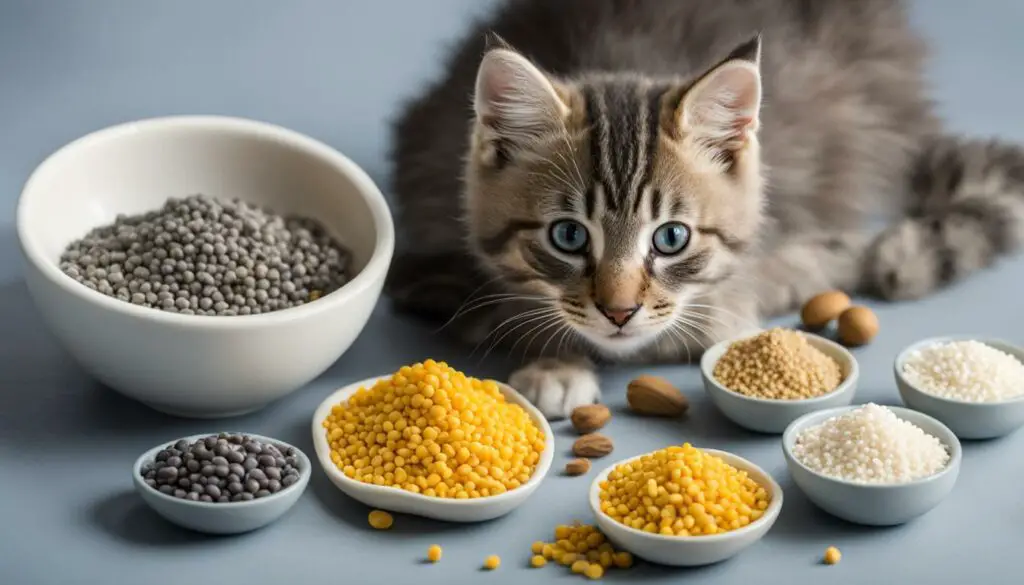
| Calcium Requirement | Phosphorus Requirement | |
|---|---|---|
| Kittens | 0.5-0.8% | 0.3-0.5% |
| Adult Cats | 0.3-0.5% | 0.2-0.4% |
As mentioned earlier, kittens have higher calcium and phosphorus requirements compared to adult cats. The table above provides a general guideline for the recommended levels of these minerals in a kitten’s diet. However, it’s important to note that individual kittens may have specific needs based on their size, breed, and health conditions. Consulting with a veterinarian is always recommended to ensure you are meeting the specific requirements of your kitten.
By understanding the importance of calcium and phosphorus and providing the right balance of these minerals in your kitten’s diet, you can support their bone and muscle development and set them up for a healthy and active life.
Switching to Adult Cat Food
When it comes to transitioning your kitten to adult cat food, it’s important to do so gradually to minimize gastric discomfort. Kittens can typically make the switch around their first birthday. By gradually shifting their diet over a 7- to 10-day period, you can help their digestive system adjust to the new food.
Start by mixing a small amount of adult cat food with their current kitten food. Over the course of the transition, gradually increase the proportion of adult food while decreasing the amount of kitten food. This slow shift allows their taste buds and stomach to adapt without causing any digestive upsets.
Remember to monitor your kitten during the transition period. If you notice any signs of gastric discomfort, such as vomiting or diarrhea, slow down the transition process. Give their digestive system more time to adjust before making further changes to their diet.
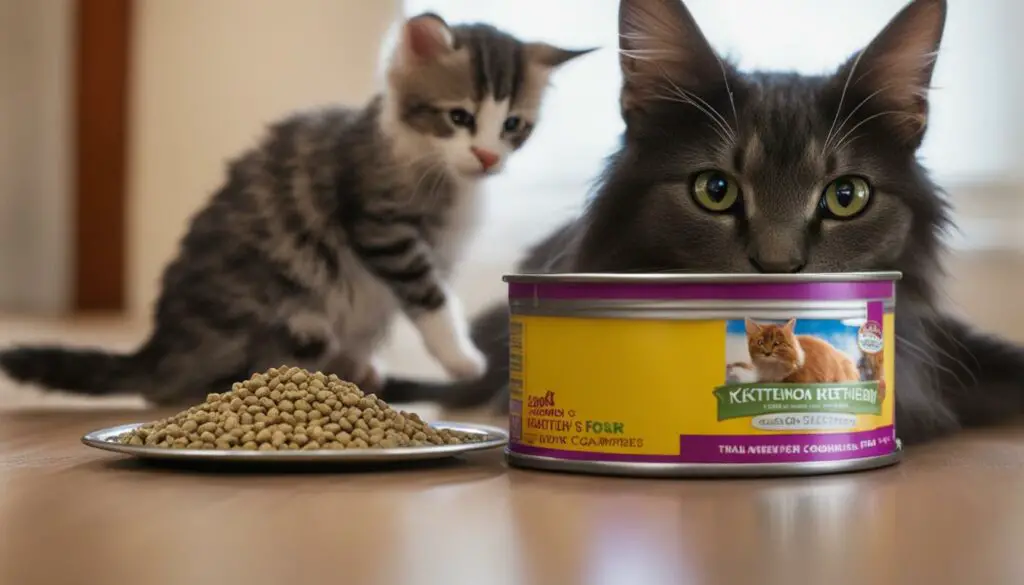
Age of Transition
The age at which a kitten can switch to adult cat food may vary slightly depending on their individual needs and development. However, most kittens are ready for the transition around the age of one year. This is when they have reached their full growth and development, and their nutritional requirements begin to align with those of adult cats.
Keep in mind that some larger cat breeds may require a longer period on kitten food to support their growth. Consult with your veterinarian to determine the best time to switch your kitten to adult cat food based on their specific breed and development.
By following a gradual shift and monitoring your kitten’s response, you can ensure a smooth transition to adult cat food and support their ongoing health and nutrition needs.
What Happens If a Kitten Eats Adult Cat Food
If a kitten accidentally eats adult cat food, it is not harmful in small amounts. However, regularly feeding them adult cat food can lead to potential effects such as nutritional deficiencies. Kittens have specific nutritional requirements during their growth stage, and adult cat food may not provide all the essential nutrients they need for healthy development.
Feeding kittens adult cat food on a regular basis can result in nutritional deficiencies, as their bodies require higher levels of protein, energy, and minerals during their growth period. Adult cat food is typically formulated to meet the needs of fully grown cats and may not contain sufficient amounts of these essential nutrients for kittens.
Therefore, it is crucial to ensure that kittens have access to their own appropriate food and prevent them from eating the older cat’s food. Providing separate feeding areas and monitoring their eating habits can help prevent the kitten from consuming adult cat food, thus avoiding potential nutritional deficiencies and supporting their optimal growth and development.
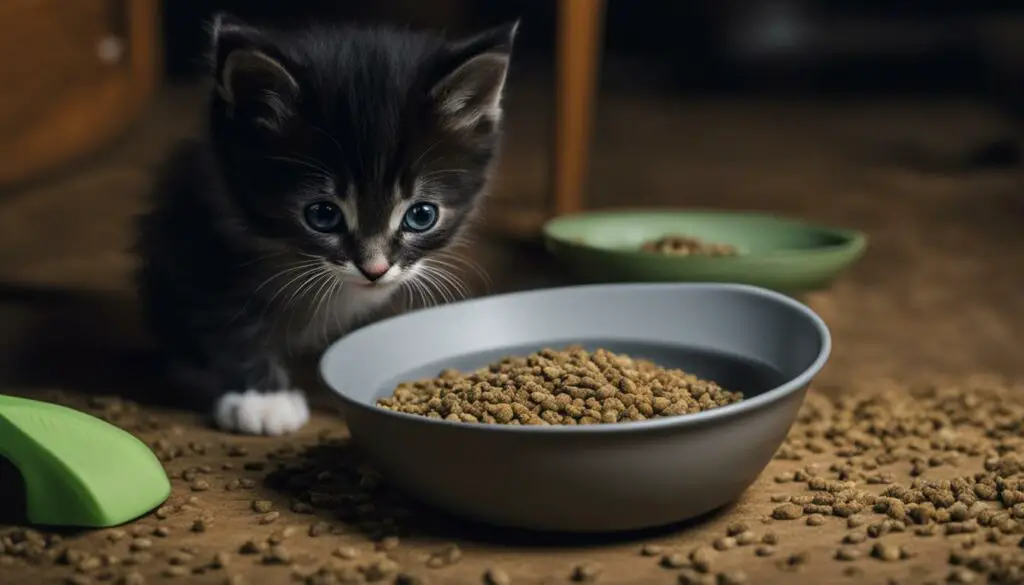
Managing Feeding Habits for Kittens and Older Cats
When it comes to feeding both kittens and older cats, it’s important to establish separate feeding areas to prevent the kitten from eating the older cat’s food. By providing designated spaces for each cat, you can ensure that they are receiving the appropriate nutrition for their age and stage of life.
Consistency is key when it comes to the brand and type of food you feed your cats. Using the same brand and type of food for both the kitten and the older cat can help maintain a balanced diet and prevent any potential digestive issues. It’s important to consult with your veterinarian to determine the specific nutritional needs of your cats and choose a high-quality cat food that meets those requirements.
Observation is an essential part of managing feeding habits for kittens and older cats. By monitoring their behavior and preferences during mealtime, you can identify any potential issues or challenges. This allows you to make any necessary adjustments to ensure that both cats are receiving the appropriate amount of food and are not interfering with each other’s meals.
Table: Recommended Practices for Managing Feeding Habits
| Practice | Description |
|---|---|
| Separate feeding areas | Provide designated spaces for the kitten and older cat to prevent them from eating each other’s food. |
| Consistent brand and type of food | Feed both cats the same brand and type of food to ensure a balanced diet and prevent digestive issues. |
| Observation | Monitor the behavior and preferences of both cats during mealtime to identify any challenges and make necessary adjustments. |
By following these recommended practices for managing feeding habits, you can ensure that both your kitten and older cat are getting the nutrition they need and minimize any conflicts or issues during mealtime. Remember to consult with your veterinarian for personalized guidance based on your cats’ specific needs and requirements.
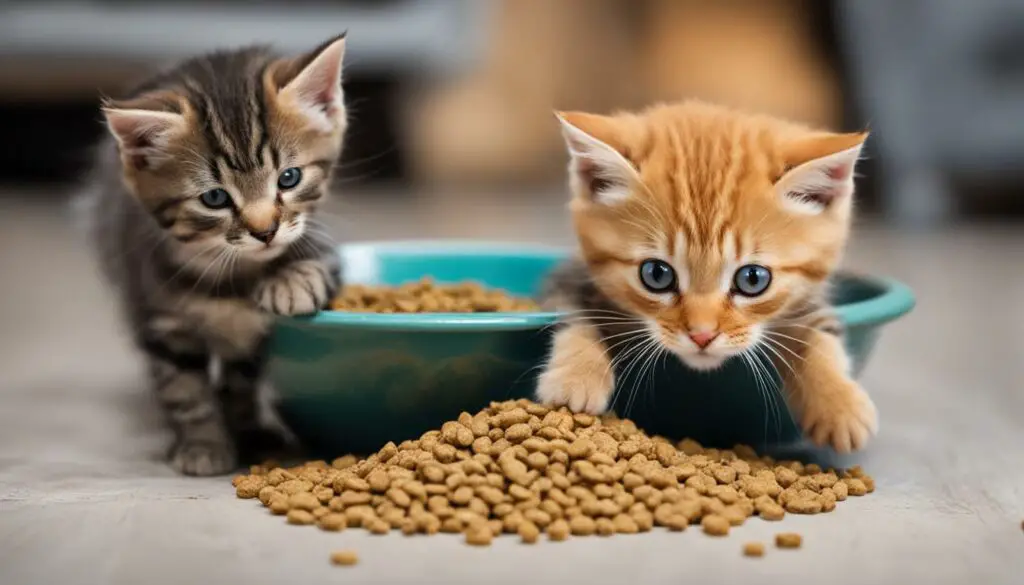
Tips for Preventing Kitten from Eating Older Cat’s Food
When it comes to feeding time, it’s important to supervise both your kitten and older cat to prevent the kitten from eating the older cat’s food. Here are some tips to help you manage their mealtime:
- Supervise during mealtime: Keep a close eye on both cats while they eat. This will allow you to intervene if the kitten tries to sneak into the older cat’s food bowl.
- Implement timed feedings: Establish a feeding schedule for both cats. This will help ensure that each cat gets their own designated mealtime and reduces the likelihood of the kitten trying to steal the older cat’s food.
- Use interactive feeding toys: Provide the kitten with interactive feeding toys. These toys are designed to dispense small amounts of food at a time, encouraging the kitten to focus on its own meal instead of trying to access the older cat’s food.
- Try food puzzles: Food puzzles are another great option to keep the kitten engaged during mealtime. These puzzles require the kitten to work for its food, stimulating their natural hunting instincts and diverting their attention from the older cat’s food.
By following these tips, you can help ensure that your kitten gets the proper nutrition it needs without interfering with the older cat’s mealtime.
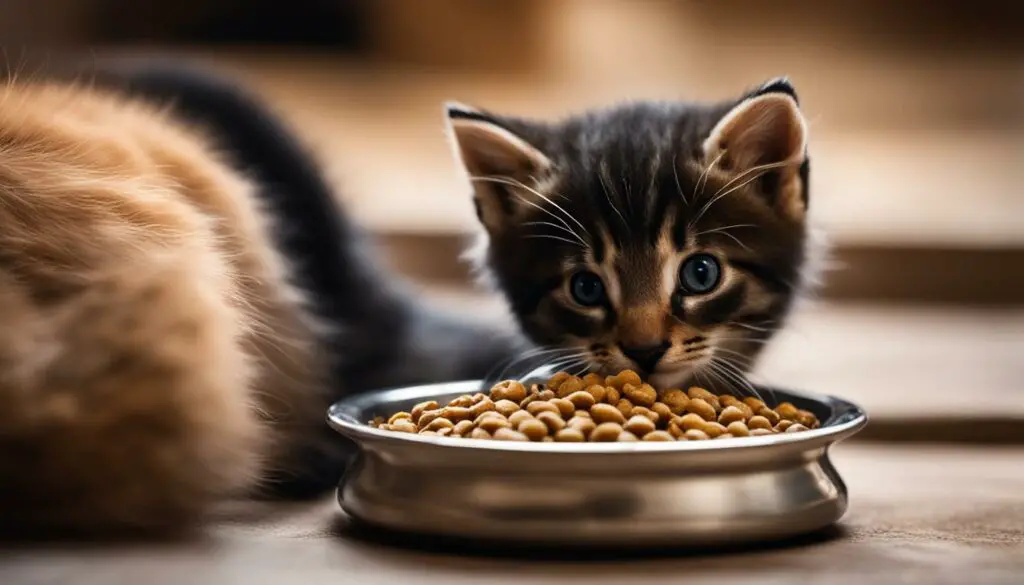
Example of an Interactive Feeding Toy:
“The TRIXIE 5-in-1 Activity Center for Cats is a great interactive feeding toy for kittens. It features different compartments and challenges that require the kitten to use its paws or nose to access the food. This not only keeps the kitten entertained during mealtime but also prevents it from trying to eat the older cat’s food.”
Ensuring Proper Hydration
When it comes to caring for your kitten’s health, hydration is just as important as nutrition. Water is a vital nutrient for cats of all ages, including kittens. It plays a crucial role in many bodily functions and helps support overall well-being.
Providing fresh water for your kitten is essential. Make sure to have a clean water bowl available at all times in an easily accessible location. Keep an eye on the water level throughout the day and refill it as needed. You can also consider using a cat water fountain, as some kittens may be more enticed to drink from flowing water.
If you notice that your kitten is not drinking enough water, there are a few things you can try to encourage them. Some kittens prefer running water, so you can try gently dripping water from a faucet into their bowl. Additionally, you can try placing multiple water bowls in different areas of your home to make it more convenient for them to access.
| Signs of Dehydration in Kittens | Ways to Encourage Hydration |
|---|---|
|
|
Remember, kittens are more susceptible to dehydration than adult cats due to their smaller size and higher activity levels. Ensuring proper hydration is essential for maintaining their health and well-being.
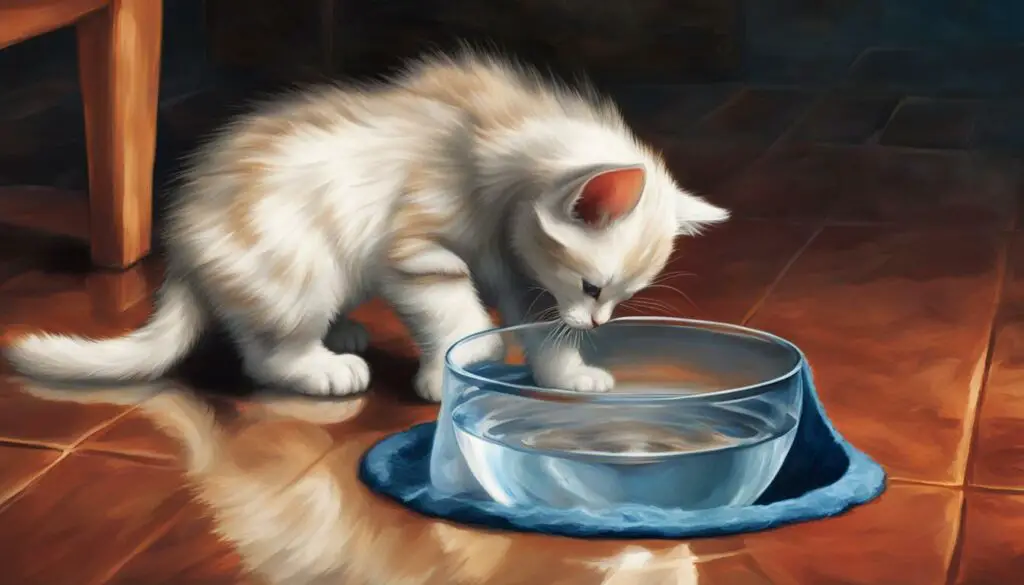
Conclusion
In conclusion, ensuring proper nutrition for kittens is vital for their healthy growth and development. Feeding them a complete and balanced kitten formula until they are at least 1 year old is crucial to provide the essential nutrients they need. It is important to prevent kittens from eating older cat’s food as it can lead to nutritional deficiencies and hinder their optimal growth.
Managing feeding habits is key to preventing access to older cat’s food. Providing separate feeding areas for the kitten and older cat, and offering consistent brand and type of food can help in this regard. Keeping a close eye on mealtime and supervising their eating habits can also be beneficial.
Additionally, ensuring proper hydration by providing fresh water is essential for kittens and cats of all ages. Water is a vital nutrient that supports their overall health.
By following these guidelines and taking care of their nutritional needs, you can ensure that your kitten grows up healthy and strong, while preventing any potential harm from eating adult cat’s food.
FAQ
What happens if my kitten eats my older cat’s food?
Feeding your kitten adult cat food can lead to nutritional deficiencies and hinder their growth. Kittens have specific nutritional requirements that adult cat food may not provide.
Can a kitten eat adult cat food?
While a small amount of adult cat food is not harmful, regularly feeding kittens adult cat food can have negative health effects. It is important to feed them a complete and balanced kitten formula until they are at least 1 year old.
How can I prevent my kitten from eating my older cat’s food?
To prevent this, it is recommended to feed kittens and older cats separately in different areas. Consistency in the brand and type of food is also important. Observing their behavior can help manage their feeding habits effectively.
When can a kitten transition to adult cat food?
Kittens can transition to adult cat food around their first birthday. It is recommended to make the switch gradually over a 7- to 10-day period to minimize gastric discomfort.
What should I do if my kitten accidentally eats adult cat food?
Accidentally eating adult cat food in small amounts is not harmful. However, regularly feeding them adult cat food can lead to nutritional deficiencies. Ensure that kittens have access to their own appropriate food to prevent them from eating the older cat’s food.
How can I manage feeding habits for both kittens and older cats?
Feeding them separately in different areas, using consistent brand and type of food, and observing their behavior and preferences can help manage their feeding habits effectively.
What are some tips for preventing a kitten from eating older cat’s food?
Supervising mealtime, implementing timed feedings, and using interactive feeding toys or food puzzles can keep the kitten focused on its own food and prevent access to the older cat’s food.
How important is proper hydration for cats?
Providing fresh water is essential for cats of all ages, including kittens. Water is the most vital nutrient and should always be available to keep them hydrated and support their overall health.
Source Links
- https://petpedia.co/can-kittens-eat-adult-cat-food/
- https://www.petcoach.co/question/?id=534808
- https://cats.com/can-kittens-eat-cat-food

